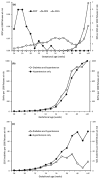A Consilience of Inductions Supports the Extended Fetuses-at-Risk Model
- PMID: 26768055
- PMCID: PMC4693682
- DOI: 10.1111/ppe.12260
A Consilience of Inductions Supports the Extended Fetuses-at-Risk Model
Figures


Comment in
-
No Rates Were Harmed in the Making of This Paper: Response to Critiques.Paediatr Perinat Epidemiol. 2016 Jan;30(1):25-7. doi: 10.1111/ppe.12266. Paediatr Perinat Epidemiol. 2016. PMID: 26768059 No abstract available.
Comment on
-
Implications of Using a Fetuses-at-Risk Approach When Fetuses Are Not at Risk.Paediatr Perinat Epidemiol. 2016 Jan;30(1):3-10. doi: 10.1111/ppe.12254. Paediatr Perinat Epidemiol. 2016. PMID: 26768054
Similar articles
-
[The effect of air contact on microblood samples of fetuses].Gynaecologia. 1966;161(4):277-87. Gynaecologia. 1966. PMID: 5958745 German. No abstract available.
-
Neuroeconomics: the consilience of brain and decision.Science. 2004 Oct 15;306(5695):447-52. doi: 10.1126/science.1102566. Science. 2004. PMID: 15486291 Review.
-
Hormonal evidence of selection in utero revisited.Am J Hum Biol. 2015 May-Jun;27(3):426-31. doi: 10.1002/ajhb.22655. Epub 2014 Nov 8. Am J Hum Biol. 2015. PMID: 25382092
-
Effects of fetus weight, dam strain, dam weight, and litter size on the craniofacial morphogenesis of CL/Fr mouse fetuses affected with cleft lip and palate.Cleft Palate Craniofac J. 1997 Jul;34(4):325-30. doi: 10.1597/1545-1569_1997_034_0325_eofwds_2.3.co_2. Cleft Palate Craniofac J. 1997. PMID: 9257023
-
The second-trimester fetus with Down syndrome: detection using sonographic features.Ultrasound Obstet Gynecol. 1996 Feb;7(2):147-55. doi: 10.1046/j.1469-0705.1996.07020147.x. Ultrasound Obstet Gynecol. 1996. PMID: 8776242 Review.
Cited by
-
Association of Race/Ethnicity With Very Preterm Neonatal Morbidities.JAMA Pediatr. 2018 Nov 1;172(11):1061-1069. doi: 10.1001/jamapediatrics.2018.2029. JAMA Pediatr. 2018. PMID: 30208467 Free PMC article.
-
The Effect of Prenatal Treatments on Offspring Events in the Presence of Competing Events: An Application to a Randomized Trial of Fertility Therapies.Epidemiology. 2020 Sep;31(5):636-643. doi: 10.1097/EDE.0000000000001222. Epidemiology. 2020. PMID: 32501812 Free PMC article. Clinical Trial.
-
The curse of the perinatal epidemiologist: inferring causation amidst selection.Curr Epidemiol Rep. 2018 Dec;5(4):379-387. doi: 10.1007/s40471-018-0172-x. Epub 2018 Sep 27. Curr Epidemiol Rep. 2018. PMID: 31086756 Free PMC article.
-
The fetuses-at-risk approach: survival analysis from a fetal perspective.Acta Obstet Gynecol Scand. 2018 Apr;97(4):454-465. doi: 10.1111/aogs.13194. Epub 2017 Aug 29. Acta Obstet Gynecol Scand. 2018. PMID: 28742216 Free PMC article. Review.
-
Who Is at Risk for Stillbirth? The Discussion Continues.Paediatr Perinat Epidemiol. 2025 Feb;39(2):205-206. doi: 10.1111/ppe.13179. Epub 2025 Feb 5. Paediatr Perinat Epidemiol. 2025. PMID: 39909822 Free PMC article. No abstract available.
References
-
- Yudkin PL, Wood L, Redman CWG. Risk of unexplained stillbirth at different gestational ages. Lancet. 1987;1:1192–1194. - PubMed
-
- Joseph KS. Incidence-based measures of birth, growth restriction and death can free perinatal epidemiology from erroneous concepts of risk. Journal of Clinical Epidemiology. 2004;57:889–897. - PubMed
-
- Page JM, Pilliod RA, Snowden JM, Caughey AB. The risk of stillbirth and infant death by each additional week of expectant management in twin pregnancies. American Journal of Obstetrics and Gynecology. 2015;212:630.e1–630.e7. - PubMed
-
- Basso O. Implications of using a fetuses-at-risk approach when fetuses are not at risk. Paediatric and Perinatal Epidemiology. 2016;30:3–10. - PubMed
-
- Joseph KS. The natural history of pregnancy: diseases of early and late gestation. BJOG: An International Journal of Obstetrics and Gynaecology. 2011;118:1617–1629. - PubMed
Publication types
MeSH terms
Grants and funding
LinkOut - more resources
Full Text Sources
Other Literature Sources

